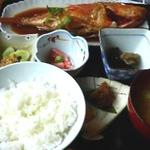
純の番屋
Junnobanya
3.37
Raus-Shiretoko Peninsula, Notsuke Peninsula, Konsen Plateau
「Seafood」
--
3,000-3,999円
Opening hours: 8:30~16:00
Rest time: Open daily Open hours and holidays are subject to change, so please check with the store before visiting.
北海道目梨郡羅臼町礼文町2-8
Photos
(20)
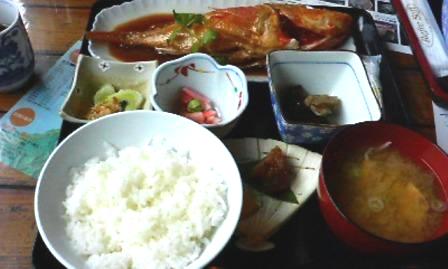
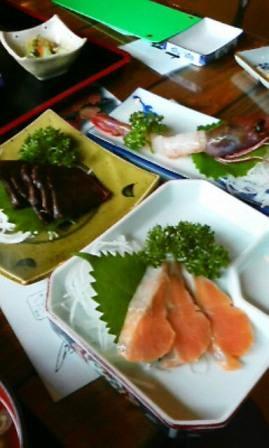
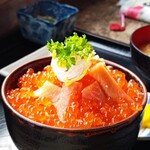
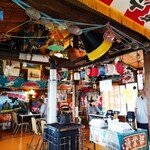
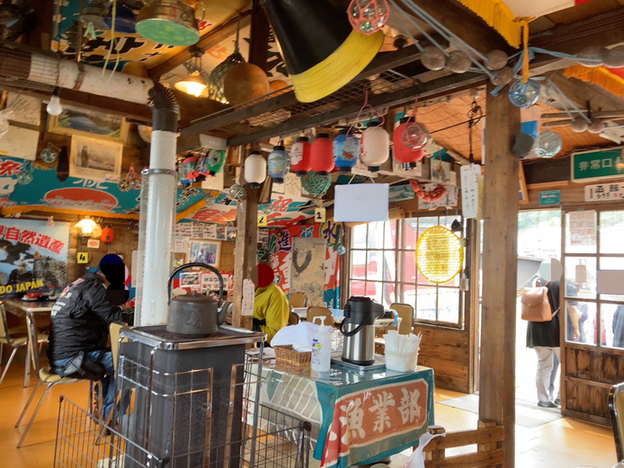
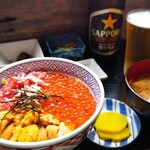
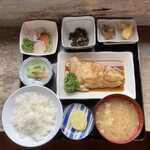
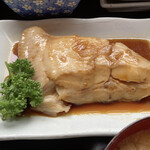
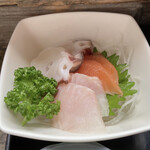
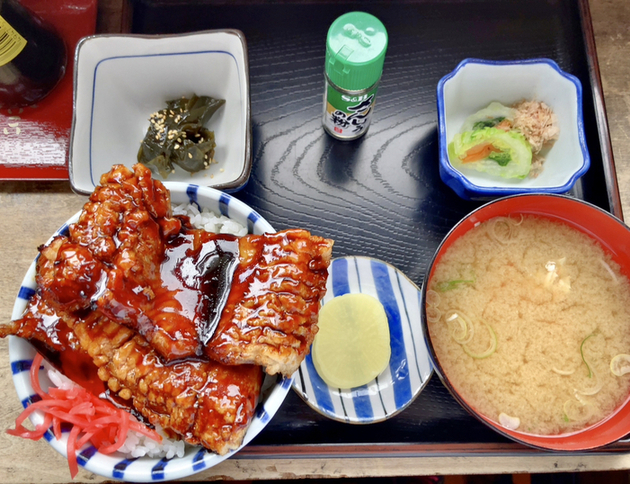
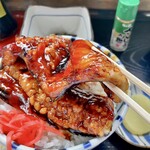
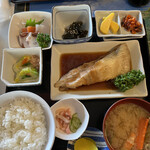
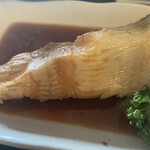
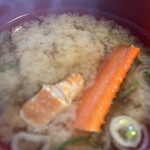
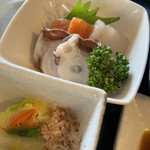
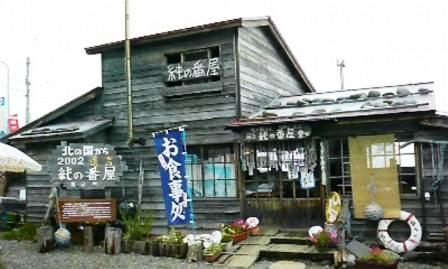
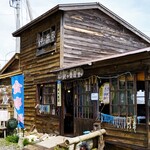
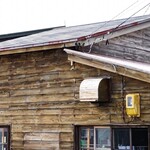
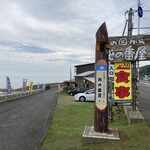
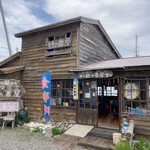
Details
Reservation Info
can be reserved
Payment Method
Cards accepted
(AMEX)
Electronic money is not accepted.
Number of Seats
35 seats
Private Dining Rooms
None
Smoking and Non-Smoking
No smoking at the table
Parking
Yes
For 20 cars
Comments
(21)
ぺんけ
5.00
Inside the restaurant: The name of the restaurant is "Jun no Banya," but the interior design and layout are completely different from the set of "From the Northern Country 2002 Will." It feels like a typical roadside eatery, nostalgic for older people and fresh for younger ones.
Service: Local fishermen's mothers and wives seem to work here. The service is very simple. If it's a slow period or time, you might hear some valuable local stories.
- Raust Donburi: A generous serving of 10 types of toppings including salmon, button shrimp, sea urchin, salmon roe, squid, herring roe, octopus, scallop, tuna, and crab meat! The taste and texture were surprisingly amazing. I have been in Kushiro for over half a century, but I have never encountered such delicious sashimi. It's even better than the popular donburi at the Kushiro Washo Market or the seafood donburi at Kushinosuke in Kushiro Town!
- Raust Tsubu Sashimi: Fresh sea urchin sashimi. It was outstanding, surpassing all the other places I have tried in Kushiro and Erimo area.
- Tokisake Sashimi: The quality of the sashimi here is exceptional. The slightly fatty and firm texture, along with the intense salmon flavor, was unmatched.
Overall, I was overwhelmed by the potential of the seafood in Rausu. This restaurant, managed by Funaki Shoten located on the first floor of the "Michi no Eki Rausu," offers impeccable seafood dishes due to their experience as fish wholesalers.
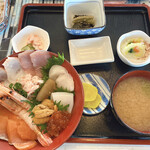
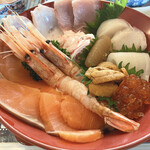
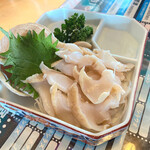
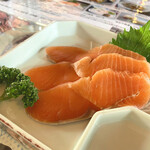
SV650S
3.40
I have never watched the drama "From the Northern Country" but it still reminds me of Hokkaido. The restaurant used in the drama, a small hut, has been turned into a shop. Similar to the Kaito Shokudo in Wakkanai, here too there is a shortage of sea urchin, so I had to settle for a salmon set meal. As expected from Rausu, the fish was fatty and delicious!
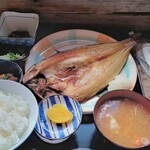
pikomaro
3.30
I went to Shiretoko. It's a place that even locals find hard to visit. If you live nearby, you should go. In Rausu, I had a delicious black cod rice bowl for 1000 yen, fresh sashimi for 680 yen, and a sashimi set meal for 1650 yen. The cod was thick and juicy, and the sashimi with sea urchin and octopus was delicious.
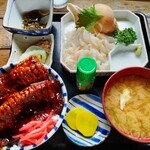
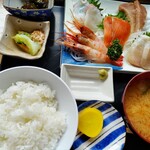
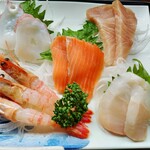
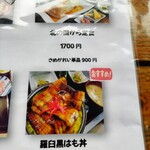
Sana625
4.50
I recreated the "From the Northern Country 2002 Will" watchman's hut. It is a dining room run by the mothers of Rausu, where I had sea urchin rice bowl and grilled hokke fish. The hokke fish was thick and juicy with a crispy skin, very delicious! The sea urchin rice bowl had plenty of fresh sea urchin without any additives, it was sweet! Sweet! This is the real sea urchin!! It was so delicious that I was at a loss for words. My friend had the Abashiri beer draft, which surprised us with its blue color. We bought some to take home as souvenirs. Even though we arrived just before closing time, the mothers welcomed us warmly and kindly.
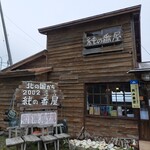
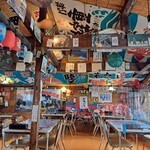
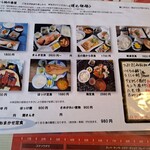
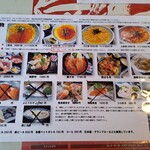
big_s278
3.50
The black conger eel rice bowl with crushed sashimi was delicious, especially the Baba Karei simmered fish in the set meal. The sashimi was fresh and tasty. There were surprisingly many dishes in the set meal, which was great.
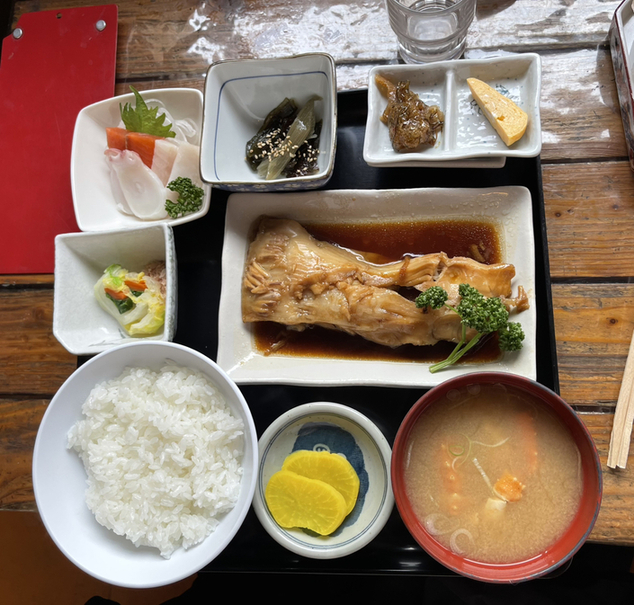
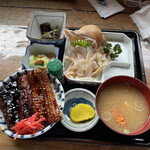
nifun
3.40
I ordered the following during my visit in the afternoon: ・Rausu black cod rice bowl [1,000 yen] ・Salmon sashimi [1,000 yen] The black cod rice bowl had thick, sweet sauce on top of the meaty flesh. It had a chewy texture and tasted similar to eating eel. It was definitely delicious. The salmon sashimi had just the right amount of fat. It was not too heavy and had a refreshing taste. This was also delicious.
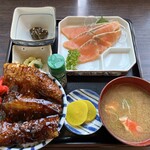
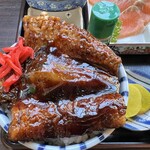
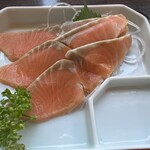

ShigeruN
3.30
I visited this restaurant instead of eating at the roadside station, and the experience was good. It is located in a tourist area, but I didn't have to wait long and enjoyed a delicious meal. In addition to the food, I also purchased some reasonably priced Rausu kelp.
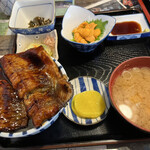
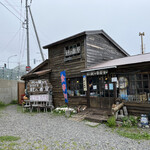
ちるちるみちる!
3.40
On a weekday during a trip, four of us visited the restaurant around 11:30 am. The interior had around 8 tables for 4 people each and a counter with 2 seats. We were seated immediately. The atmosphere was very nice. We ordered the "From the Northern Country" set meal for 1700 yen, the "Golden Eye Snapper" set meal for 2980 yen, and the "Three-color Bowl" half size for 2300 yen (choice of sea urchin, crab, salmon roe, or scallop). The simmered kelp side dish was very tender and delicious. The crab soup had a rich flavor. The golden eye snapper and noodles were also very flavorful. The amount of the rice bowl was just right, and it was a satisfying meal.




ゆきたべゆっきー
4.00
The atmosphere is great! It feels like something out of "From the North Country." I'm not sure about the prices, but I highly recommend the donburi with clams and sashimi - it was delicious with no complaints! I think it was called Rausu donburi. Also, the popular Kinmedai (splendid alfonsino) simmered dish at the restaurant was also delicious with great flavors. I'm glad I asked at the roadside station. This is the epitome of satisfying Hokkaido food.
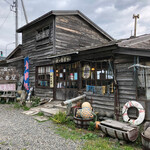
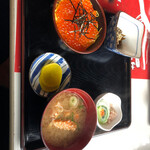
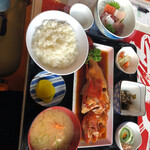
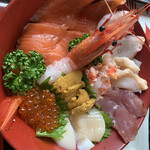
タカジュンランド♫
4.00
I went to Jun's Banya. It was great! I recommend the grilled flatfish bowl and the grilled salmon set, which we shared between two people. Everything, including the side dishes, was delicious! Highly recommend when you visit Rausu! Thank you for the meal!
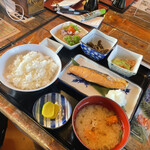
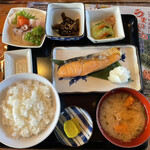
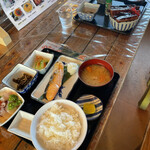
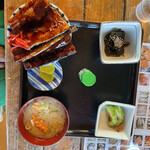
飲みニスト0430
4.00
During the summer vacation, I visited Rausu in Hokkaido for a 3-day trip. Today, on the third day, I enjoyed a sightseeing boat tour in Shiretoko in the morning and then arrived in Rausu for lunch. We went to a restaurant called "Jun no Banya," which recreates the setting of a northern country. Before being seated, we placed our order at a spot where the dishes were displayed. Today, we ordered the following: - Kin-ki set meal - Uni and ikura donburi x2 The Uni and ikura donburi was filled with plenty of sea urchin and salmon roe, which really lifted our spirits. It was nice to be able to enjoy two different types of sea urchin and salmon roe. The Kin-ki set meal included kin-ki simmered fish, simmered kelp, additive-free cod roe, boiled vegetables, vinegar dish, rice, crab soup, and pickles, all for 3300 yen. The kin-ki simmered fish was incredibly fatty and had a tender texture, making it dangerously delicious!
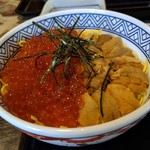
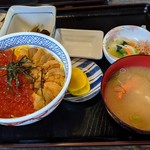
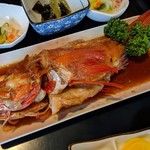
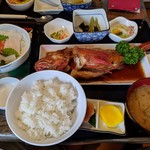
くまのつま
3.50
I visited this restaurant for lunch before going whale watching. I'm actually from a northern country and haven't seen much of this kind of cuisine, but my husband wanted to come here. There were autographs from director Satoshi Kuramoto and other main actors, so I wonder if it was used for filming? I'm sorry to the fans of "From the North Country" if an amateur like me visited the restaurant. When I entered, there was a menu on the left side with actual dishes, and the lady there explained them to me. There were so many recommendations, I was really torn. When I honestly told her that, she said, "Take your time deciding." But I couldn't keep deciding forever! In the end, I chose the simmered shark ray (a type of flounder I had never heard of) set meal and the sashimi set meal. The shark ray was so fatty and had thick flesh, it was delicious! The sashimi included salmon, button shrimp, and 10 other luxurious varieties. The sea urchin melted in my mouth with its rich flavor. The refreshing sea breeze from the window, the warm atmosphere of the restaurant, the fresh fish dishes - it was a wonderful place.
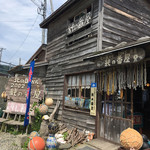
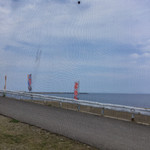
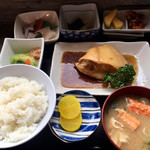
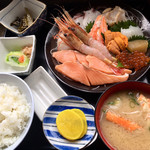
eb2002621
3.80
On the 3rd day of July 2019 in Hokkaido, after checking out of Hotel Kisuien Shiretoko, I stopped by the Michi no Eki "Shiretoko Laus" and arrived at "Jun no Banya". I haven't watched the "From the Northern Country" series, but the atmosphere here is nice. I was the first customer of the day as they had just opened. I ordered the "Chef's Choice Set Meal" limited to 10 servings for 980 yen. As I was the first customer of the day, they also gave me a complimentary coffee. The set meal included rice, miso soup, pickles, lightly pickled cabbage, carrots, and spinach, fuki kombu sesame simmered dish, flounder and salmon sashimi, simmered flounder, and coffee. The sashimi and simmered dishes were delicious. The meal was satisfying in terms of taste and portion size. Thank you for the meal!
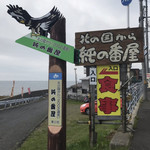
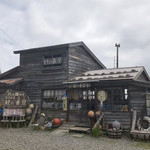
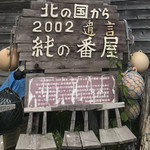
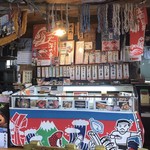
heiza311
2.60
We stopped by for lunch during our trip to Hokkaido. We planned to have a quick bite along the way, so we ordered one bowl dish and a seafood stew to share between two people. It was delicious and fresh. The distance of transportation really affects the freshness of the ingredients. However, the prices were a bit high due to being in a tourist area. The atmosphere was nice, and overall, it was a decent meal during our travels. Price: average, Food: good, Value for money: average, Atmosphere: good, Service: good, Likely to revisit: no, mainly due to the location. It would be a good choice for tourists visiting the area.
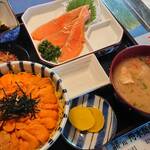
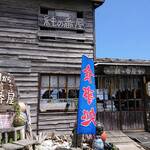
ichi.262
3.50
At the Roadside Station Rausu, the Funaki Shoten shop offered us plenty of samples of sea urchin and crab, but we couldn't buy any as souvenirs. As a thank you, we had lunch at this Jyun no Banya restaurant run by Funaki Shoten. The seafood we sampled at the roadside station was so delicious that we had high expectations for the same seafood dishes at the restaurant. And it was a great choice! The sea urchin, crab, and salmon roe were all incredibly fresh and delicious! This seafood bowl we had in Hokkaido is definitely the best we've ever had.
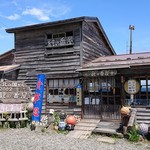
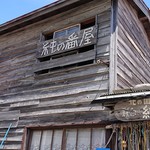
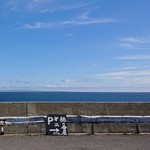
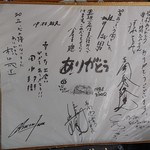
みほぱぱ♪
4.00
The bowl of hamo (pike conger) from Rausu, priced at 1000 yen, was delicious with its rich sauce and incredibly tender hamo. My companion had the chef's choice set meal for 980 yen, which featured a flavorful simmered skate wing. It looked just as tasty. I will definitely be returning to this restaurant.
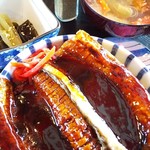
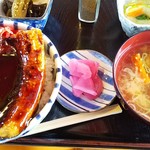
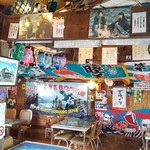
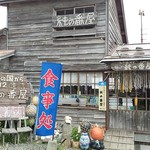
勝手気ままに
3.00
I visited the Rausu Jun no Banya, which was used as a filming location for "Kita no Kuni Kara" (From the North Country). It is now a restaurant where you can enjoy fresh seafood from Rausu. The restaurant is popular for serving freshly caught fish from Rausu. I arrived early but there were already a few cars parked outside. Inside, the owner (who seemed to be a famous lady) explained that they don't have menus on the tables and pointed out the recommended dishes featuring Rausu seafood. After some deliberation, I chose the Three-color Donburi with sea urchin, salmon roe, and crab for 2650 yen. The bowl came with crab miso soup, a side dish, and pickles. I quickly devoured the meal as I was quite hungry. It was delicious, but the sea urchin was a bit disappointing as it tasted like alum. Perhaps it was from the previous day? The crab in the bowl was tasty, but the crab in the miso soup was not as flavorful, possibly due to being frozen. Considering the price, it may be a bit expensive for locals in Hokkaido. I didn't try the sashimi from the refrigerator, but it looked fresh as it was caught that day.
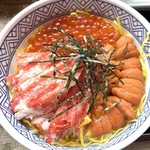
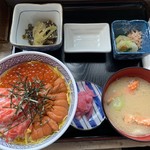
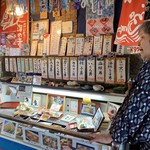
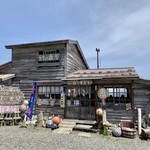
utakata.utage
3.40
After whale watching, I visited for lunch. They had unusual ingredients, and I tried grilled seal meat. The liver had a rich, powerful flavor. The set meal included a type of flounder only found in the north, simmered skate. It was thick and the fat was juicy and delicious. The miso soup had crab in it, giving it a great broth.
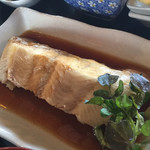
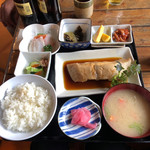
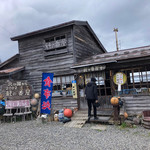
kzsg01
3.40
■ Date of visit: April 30, 2019, 11:45 AM
■ Crowdedness: Upon arrival, 12-3 customers inside, main dining area about 90% full, around 10 people waiting by 12:10 PM
■ Total spent: 3,450 yen
On the third day of my trip to Hokkaido, I used Abashiri as a base to explore Shiretoko Peninsula, Utoro, Rausu, Notsuke Peninsula, and Lake Mashu with a rental car. For lunch, I tried to go to the restaurant at "Michi no Eki Rausu," but there was a long line, so I decided to head to the restaurant recommended inside the rest area. Luckily, I was able to get a seat without waiting, but there was a line of about 10 people waiting after I ordered. I waited about 20 minutes for my order to arrive.
[What I ordered]
■ Grilled Atka mackerel set meal - 1,750 yen
A whole Atka mackerel. The flesh is not very thick, but it has a good amount of fat, making it juicy and tender. The meat separates easily from the bones, making it easy to eat without any hassle.
■ From the North Country set meal - 1,700 yen
The main dish is simmered Greenland halibut. The meat is thick and the texture is like gelatin in the cartilage parts. It is delicious with a rich and sweet simmered sauce. It also comes with sashimi, making it a good deal. The set meal includes simmered kelp, 3-4 side dishes, and the rice is very tasty. Although the prices are not cheap, the local ingredients are delicious, and the atmosphere of the fishing hut along the coast is enjoyable. It is a good restaurant where you can truly feel the essence of Shiretoko.
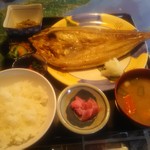
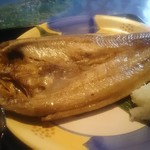
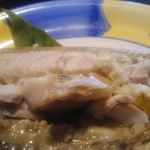
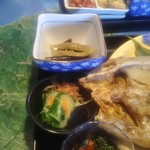
大阪めんま
4.00
Located in the southeastern part of the Shiretoko Peninsula in Rausu Town, Hokkaido, is a restaurant run by a seafood processing company called "Funaki Shoten." The most notable feature of this restaurant is the building that replicates the "Jun no Banya," which was the setting for the drama "Kita no Kuni Kara 2002 Yuigon." The original filming location is difficult to access, so the local tourism association, with the help of town volunteers, recreated it to allow visitors to experience the atmosphere. Although I have not watched the drama, the restaurant is appealing not only to fans but also to those looking to enjoy fresh seafood from the sea of Rausu.
I visited the restaurant for breakfast before heading to Shiretoko for sightseeing. Following the signs along National Route 335 that runs along the coastline, I found a unique cabin with a distinct atmosphere. Arriving on a Sunday just after 9 am, the restaurant was already bustling with quite a number of customers. The menu offers a variety of Hokkaido's classic seafood such as salmon, sea urchin, salmon roe, alfonsino, and Okhotsk Atka mackerel, as well as rare local seafood unique to Rausu. There were items like black hamo, spotted halibut, the rare and expensive grape shrimp, and even sea horse meat available. I ordered the Tokishirazu set meal, Toko meat sashimi, and the rare "Salmon Juvenile" sashimi.
[Tokishirazu Set Meal] ¥1,780 (tax included)
This luxurious set meal includes grilled Tokishirazu, salmon roe, sashimi, pickles, boiled vegetables, and crab soup. Salmon caught in Hokkaido is divided into autumn salmon and Tokishirazu (spring salmon). Autumn salmon returns to Hokkaido rivers and is a taste of autumn starting from August. On the other hand, Tokishirazu is a salmon estimated to return to rivers such as the Amur River in Russia, migrating around Japan from spring to summer when it is caught. Tokishirazu is known for having excellent fat content as it accumulates nutrients before spawning, with fat content said to be three to four times higher than autumn salmon. The grilled salmon had a rich fat content, making it very appetizing. The salmon roe and sashimi were also delicious, and the rice disappeared in an instant.
[Rare Salmon Juvenile Sashimi] ¥1,000 (tax included)
Although a bit pricey for three slices, Salmon Juvenile (Keiji) is a highly prized fish. Like Tokishirazu, Salmon Juvenile is a young chum salmon born in rivers such as the Amur River, mainly caught from Shiretoko to the vicinity of Abashiri in early to mid-November. It is considered a rare delicacy as only one to two fish are caught per 10,000 fish. The distinguishing feature is its incredible fat content, often described as being in a completely toro (fatty) state. The sashimi served was frozen, but the exceptional fat content that melts in your mouth was evident. Delicious, but indeed expensive.
[Grilled Sea Horse] ¥700 (tax included)
I had heard of the rare delicacy of sea horse meat in Hokkaido before. Sea horses are considered "gangsters of the sea" by fishermen as they are pests causing damage to fisheries. Sea horse meat is known to have a strong taste, but the sea horse meat at this restaurant was marinated in a bold sauce, completely eliminating any unusual taste. The meat was tender and had a flavor reminiscent of whale red meat, surprisingly delicious.
I indulged in a hearty breakfast with a variety of unique dishes. Despite my lack of knowledge about the building and the drama, I was captivated by the nostalgic and unique atmosphere.
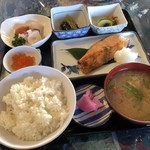
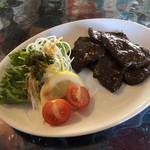
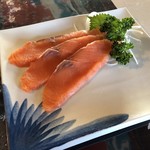
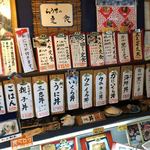
ぺん_ぺん
3.40
I visited around 8:50 for breakfast. This restaurant has a rustic atmosphere like a fisherman's hut, which was a filming location for a TV drama set in the northern country. The seafood bowl was generous in portion and deliciously fresh. As someone living in Honshu, any seafood bowl tastes great to me and seems like a good value... I tend to give generous ratings. Is this the standard in Hokkaido?
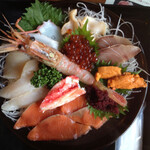
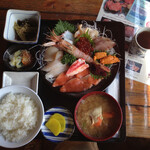
Email Login